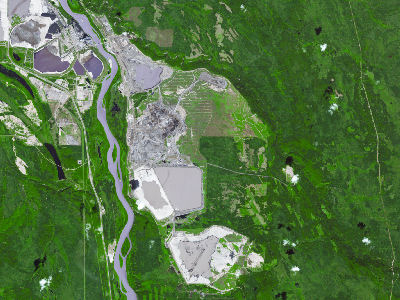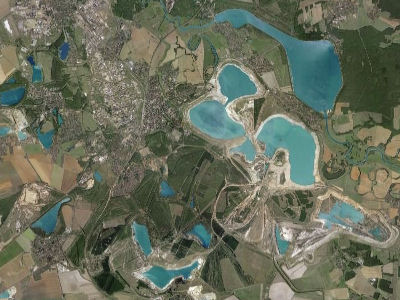4. Waste Management
Mining Waste (2/2)
In addition to mines that extract minerals, some mines are established in order to extract oil. Oil sands are extra heavy oil mixed with sand and clay. These are often found near the surface, which means that strip mining (the process of removing the top layer or rock and soil in order to access the reserves below) is the most efficient method. The oil is then extracted and the remaining material (known as tailings) are deposited in ponds.
In the image above, captured by the ASTER instrument onboard NASA's Terra satellite, is a scene of the Millennium Open Pit Mine in Alberta, Canada, next to the Athabasca river. On the top left of the image the oil sand deposits can be seen. The large grey areas in the middle and lower-middle part of the image are the tailing ponds.
The operation of the mine had huge effects on the local environment. Vegetation has been stripped in order to allow space for the creation of the surrounding pits and roads. Water from the river is being used for the refining process, but precautions are taken to stop any leackage to the stream.
Restoring Mines
After the mines stop working, the surface of the Earth is left with those mines appearing as large scars. Even though the industry is no longer inderested in the area, the state needs to restore the damaged scenery.
In Bitterfeld, in Germany, the abandoned open mines were converted into lakes. Now the area is used as a recreation park, for walking and cycling. The intorduction of water in the area, has promoted the growth of vegetation and an ecosystem is now in the making.
Waste management is also related with the introduction of waste in the marine environment. Oil spills in the ocean and pumping of chemicals in the sea can also be detected and monitored with remote sensing. For more information see the module on Marine Pollution.


